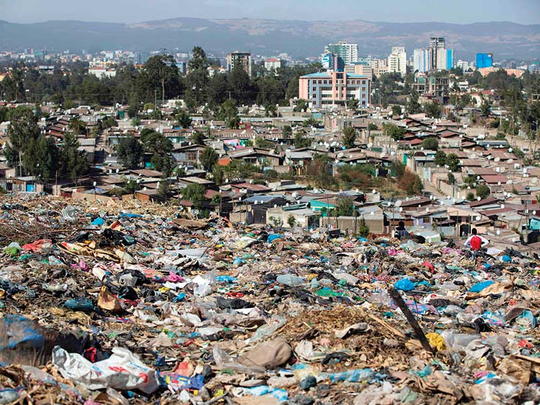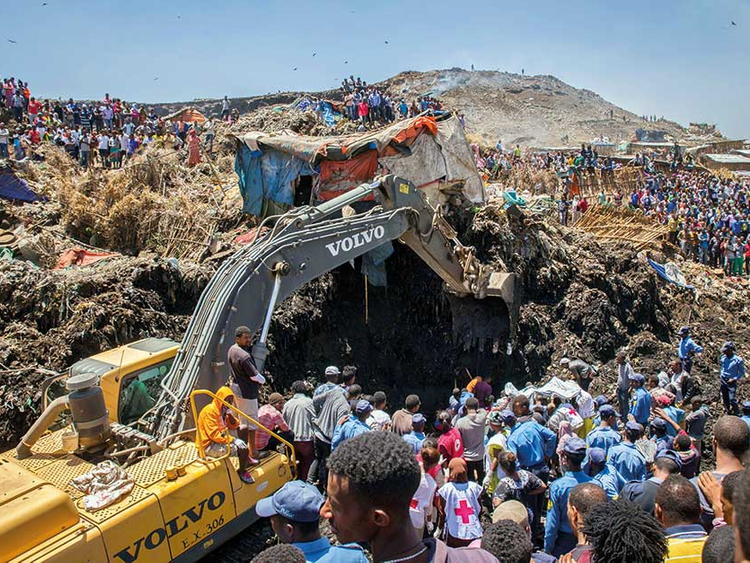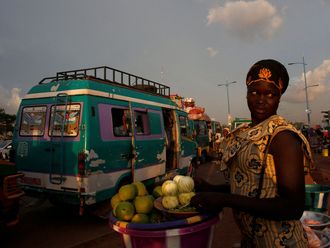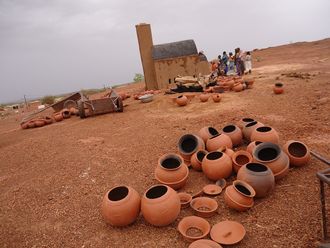
Addis Ababa
When a mountain of trash collapsed at the fetid Reppi dump outside of Addis Ababa last week, at least 82 people died.
It could’ve been worse: Hundreds of people live atop Reppi, Ethiopia’s biggest waste dump, trying to make a living from salvaging what city residents throw away. Despite well-known dangers, and the best efforts of the government, they’ve done so for decades.
And that’s not so unusual. In the developing world, open dumps are the most common way to dispose of the rising tides of waste that accompany economic growth.
Some are small. Some, like Reppi, are vast, rolling landscapes of trash, home to recycling businesses, ad hoc housing, children, livestock and swirling clouds of dust, plastic bags and opportunistic birds.
Such dumps loom as one of this century’s most pressing health and environmental challenges. According to the World Bank, cities will generate 2.2 billion tonnes of solid waste by 2025, up from 1.3 billion in 2010.
Hazards
Open dumps, typically located on the fringes of urban areas, are the primary destination for that trash. This leads to a variety of potential hazards, including water pollution, loss of biodiversity, increased greenhouse-gas emissions, and the spread of mosquito-borne illnesses such as malaria. Accidents like the one in Addis Ababa are only the most high-profile danger.
Yet dealing with waste is one of the most expensive services that governments offer.
Global solid-waste management costs will likely hit $376 billion (Dh1.38 trillion) in 2025, up from $205 billion in 2012. Some cities spend fully half their budgets on trash management, with the bulk devoted to collection and transportation. (In India, those costs account for three-quarters of solid-waste budgets.)
It shouldn’t be surprising, then, that more than half the globe’s population doesn’t have access to regular trash pickup at all. Open dumps offer a cost-effective solution to that problem.
Compared to composting, methanisation and other potential remedies, landfilling remains the cheapest and most easily managed way to throw out trash in poor countries.
Dumps also sustain vast, informal recycling programmes that are often far more efficient than those run by municipalities in richer areas. Any effort to improve waste management in the developing world must reckon with these advantages.
Answer isn’t simple
And as Addis Ababa shows, the answer isn’t as simple as building more modern facilities. Last year, the city opened what was supposed to be a sophisticated sanitary landfill, complete with liner to prevent leakage into groundwater, protocols for reducing dust and controlled access points. But mismanagement, disputes with farmers living nearby, and increased costs have all given new life to the 30-hectare Reppi dump, along with all its hazards.
Addressing such intractable problems will require more creativity. The trash-management tools commonly used in wealthier countries — such as waste reduction and waste-to-energy projects — don’t work as well in poorer cities, where budgets are strapped, corruption is rife and technical skills are lacking.
What those cities need are cheap, safe methods to manage their garbage. And that starts with building cheaper, safer landfills.
City governments should follow the lead of World Bank projects in places such as Tanzania, where workers in the informal waste sector are subsidised based on the number of households they serve and whether they transport trash to approved disposal sites, which can reduce environmental risks.
Another promising example is Brazil, where armies of waste pickers are organised into cooperatives, which cities then incorporate into their formal trash-management plans.
Balancing concerns
Such community-based approaches make use of an already skilled workforce, and build support for more disruptive changes in how waste is managed.
Ultimately, building better garbage dumps involves balancing environmental and public-health concerns with the demands of tight budgets and vulnerable people. It isn’t an issue likely to motivate celebrities or documentary filmmakers. But as Addis Ababa demonstrated last week, it’s a matter of life and death.
— Bloomberg














